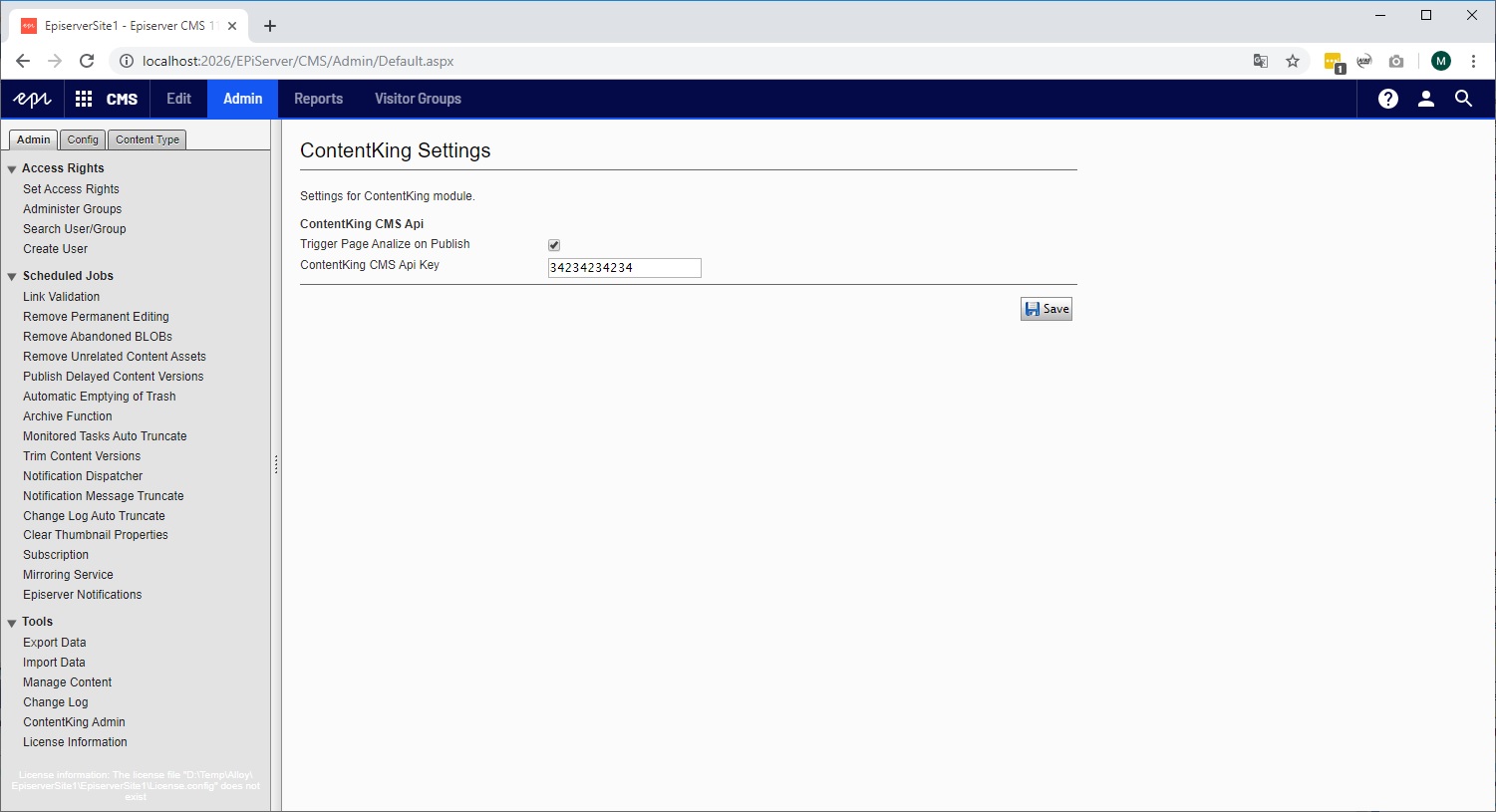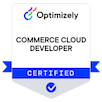Recently, I found out about the ContentKing CMS API that allows the user to trigger priority auditing of a page through an API. Basically telling ContentKing that a page has changed, and requesting re-evaluation of the SEO score.
In this blog I will explain how I integrated the CMS API in an episerver project.
Publish event
Firstly I needed to hook up to the Episerver publish event. This I did with an Initializable Module.
[InitializableModule]
[ModuleDependency(typeof(EPiServer.Web.InitializationModule))]
public class PublishEventInitializationModule : IInitializableModule
{
public void Initialize(InitializationEngine context)
{
var contentEvents = ServiceLocator.Current.GetInstance<IContentEvents>();
contentEvents.PublishingContent += contentEvents_PublishingContent;
}
public void Uninitialize(InitializationEngine context)
{
var contentEvents = ServiceLocator.Current.GetInstance<IContentEvents>();
contentEvents.PublishingContent -= contentEvents_PublishingContent;
}
void contentEvents_PublishingContent(object sender, EPiServer.ContentEventArgs e)
{
var contentKingService = ServiceLocator.Current.GetInstance<IContentKingService>();
contentKingService?.TriggerPageAudit(e.Content);
}
}
When a page is published now the ContentKingService is called to trigger page auditing. The service reads the ContentKing API key needed using a settingsservice, and uses the UrlHelper and ISiteDefinitionResolver to retrieve the full url of the page published. Then does a POST to the ContentKing API using an HttpClient.
[ServiceConfiguration(ServiceType = typeof(IContentKingService), Lifecycle = ServiceInstanceScope.HttpContext)]
public class ContentKingService : IContentKingService
{
private readonly UrlHelper _urlHelper;
private readonly ISiteDefinitionResolver _siteDefResolver;
private readonly ISettingsService _settingsService;
private string EndPointUrl = "https://api.contentkingapp.com/";
public ContentKingService()
{
_urlHelper = ServiceLocator.Current.GetInstance<UrlHelper>();
_siteDefResolver = ServiceLocator.Current.GetInstance<ISiteDefinitionResolver>();
_settingsService = ServiceLocator.Current.GetInstance<ISettingsService>();
}
public void TriggerPageAudit(IContent content)
{
var settings = _settingsService.GetSettings();
try
{
if (settings != null &&
settings.TriggerAnalyzeOnPublish &&
!string.IsNullOrEmpty(settings.CmsApiKey))
{
var fullPageUrl = ResolveUrl(content);
var url = EndPointUrl + "v1/check_url";
var requestHeaders = new NameValueCollection { { "Authorization", $"token {settings.CmsApiKey}" } };
var json = JsonConvert.SerializeObject(new
{
url = fullPageUrl
});
var result = PostObject<object>(url, json, requestHeaders);
}
}
catch
{
//ToDo Do something with exceptions..
}
}
public string ResolveUrl(IContent content)
{
var contentUrl = _urlHelper.ContentUrl(content.ContentLink);
if (contentUrl.Contains("//"))
return contentUrl;
return new Uri(_siteDefResolver.GetByContent(content.ContentLink, true, true).SiteUrl, contentUrl).AbsoluteUri;
}
private static T PostObject<T>(string url, string jsonContent, NameValueCollection requestHeaders = null)
{
var httpContent = new StringContent(jsonContent, Encoding.UTF8, "application/json");
using (var client = new HttpClient())
{
if (requestHeaders != null && requestHeaders.Count > 0)
{
foreach (string key in requestHeaders.Keys)
{
client.DefaultRequestHeaders.Add(key, requestHeaders[key]);
}
}
client.DefaultRequestHeaders.Accept.Add(new MediaTypeWithQualityHeaderValue("application/json"));
var httpResponse = client.PostAsync(url, httpContent).Result;
if (!httpResponse.IsSuccessStatusCode)
throw new Exception($"{httpResponse.StatusCode} | {httpResponse.ReasonPhrase}");
return httpResponse.Content.ReadAsAsync<T>().Result;
}
}
}
CMS Admin Page
To make the integration more flexible I wanted to create a page in the cms-admin section of Episerver to manage the ContentKing API key, and enable or disable the triggering. To create a page in cms-admin section I created a controller for the page and added the EPiServer.PlugIn.GuiPlugIn attribute.
[EPiServer.PlugIn.GuiPlugIn(
Area = EPiServer.PlugIn.PlugInArea.AdminMenu,
Url = "/ContentKingAdmin/Index",
DisplayName = "ContentKing Admin")]
public class ContentKingAdminController : Controller
{
private readonly ISettingsService _settingsService;
public ContentKingAdminController()
{
_settingsService = ServiceLocator.Current.GetInstance<ISettingsService>();
}
public ActionResult Index()
{
var model = _settingsService.GetSettings();
return View(model);
}
[System.Web.Mvc.HttpPost]
public ActionResult Save(SettingsModel model)
{
_settingsService.SaveSettings(model);
return RedirectToAction("Index");
}
}
Then I created a view to create a ui for the settings. (I stole some styling from another episerver admin page)
@{
Layout = null;
}
@model AlloyContentKing.Models.SettingsModel
<!DOCTYPE html>
<html>
<head>
<title></title>
<!-- Mimic Internet Explorer 7 -->
<meta http-equiv="X-UA-Compatible" content="IE=EmulateIE7">
<link rel="stylesheet" type="text/css" href="/EPiServer/Shell/11.19.1/ClientResources/epi/themes/legacy/ShellCore.css">
<script type="text/javascript" src="/EPiServer/Shell/11.19.1/ClientResources/ShellCore.js"></script>
<link rel="stylesheet" type="text/css" href="/EPiServer/Shell/11.19.1/ClientResources/epi/themes/legacy/ShellCoreLightTheme.css">
<script type="text/javascript" src="/EPiServer/CMS/11.19.1/ClientResources/ReportCenter/ReportCenter.js"></script>
<link href="../../../App_Themes/Default/Styles/system.css" type="text/css" rel="stylesheet">
<link href="../../../App_Themes/Default/Styles/ToolButton.css" type="text/css" rel="stylesheet">
</head>
<body>
<div class="epi-contentContainer epi-padding">
<div class="epi-contentArea">
<h1 class="EP-prefix">ContentKing Settings</h1>
<p class="EP-systemInfo">
Settings for ContentKing module.
</p>
</div>
<div class="epi-formArea">
<form id="cmsApiSettings" method="POST" action="\ContentKingAdmin\Save">
<strong>ContentKing CMS Api</strong>
<div class="epi-size20">
<div>
<label>Trigger Page Analize on Publish</label>
@Html.EditorFor(x => Model.TriggerAnalyzeOnPublish)
</div>
<div>
<label>ContentKing CMS Api Key</label>
@Html.EditorFor(x => Model.CmsApiKey)
</div>
</div>
<div class="epi-buttonContainer">
<span class="epi-cmsButton">
<input class="epi-cmsButton-text epi-cmsButton-tools epi-cmsButton-Save"
type="submit"
name="ctl00$FullRegion$MainRegion$ImportFile"
id="FullRegion_MainRegion_ImportFile"
value="Save"
title="Save">
</span>
</div>
</form>
</div>
</div>
</body>
</html>
The Admin page looks like this:

Dynamic Data Store
To store the settings I use Episerver Dynamic Data Store (DDS). To store data in the DDS you first need to create a model that Implements IDynamicData
public class SettingsModel : IDynamicData
{
public Identity Id { get; set; }
public bool TriggerAnalyzeOnPublish { get; set; }
public string CmsApiKey { get; set; }
}
The SettingsService reads or writes the settings from and to the DDS.
[ServiceConfiguration(ServiceType = typeof(ISettingsService), Lifecycle = ServiceInstanceScope.Singleton)]
public class SettingsService : ISettingsService
{
private Guid _settingsId = new Guid("05663fcf-9f39-4fc2-af49-bddfb76953e0");
public SettingsModel GetSettings()
{
var store = DynamicDataStoreFactory.Instance.CreateStore(typeof(SettingsModel));
return store.Items<SettingsModel>().FirstOrDefault(x => x.Id.ExternalId == _settingsId);
}
public void SaveSettings(SettingsModel model)
{
model.Id = _settingsId;
var store = DynamicDataStoreFactory.Instance.CreateStore(typeof(SettingsModel));
store.Save(model);
}
}
This concludes my first ever blog. Let me know what you think or if you have any questions!



